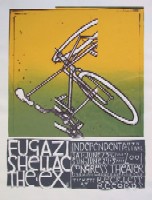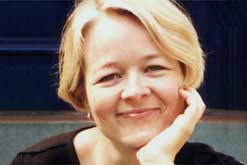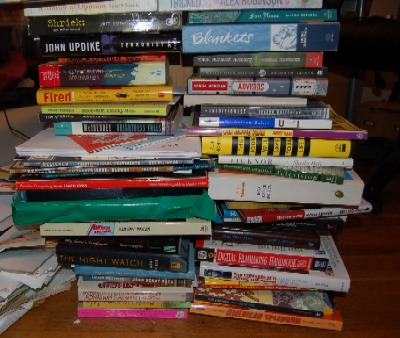Okay, I have a tremendous backlog on write-ups. Pardon me if my thoughts are ocassionally rushed here, but the only way to get this out of the way and kill the backlog is to type like mad.
Book #12 was Eliott Perlman’s Seven Types of Ambiguity. What we have here is a mammoth social novel in the Corrections/Bonfire of the Vanities/An American Tragedy tradition: a book that dares to make broad and often dead wrong generalizations in an effort to better understand human behavior.
The novel follows a troubled (well, let’s face the facts, batshit crazy) and unemployed teacher named Simon, who can’t seem to get over Anna, the girl who dumped him back in his college days. Simon thinks he’s some kind of misunderstood genius and somehow manages to coax a prostitute named Angelique, a psychiatrist and many other unexpected figures into his life. He kidnaps Anna’s son. And we hear this tale from his and many other points of view. What’s amazing is how the supporting characters are all taken in by Simon’s efforts to bring them down.
Now I know that I’m making this sound as if I hated the book. In fact, describing it makes the story sound implausible. But this isn’t exactly the case. It takes brass balls to pursue seven disparate narratives, particularly a few that I don’t think Perlman doesn’t entirely ken (that would be most of the female characters).
Somehow though, despite Perlman’s inconsistencies, you have to give him points on earnestness, a literary commodity that isn’t really valued in these hard realist times. This is a novel that starts with a bang, and it is, particularly with its business dealings, quite effective at gripping the reader, particularly during its corporate retreat chapter, which reads almost like an Elkinesque satire. There’s also something quite absurdist in making all the characters so miserable and out-of-touch with their surroundings. And I suspect that the book would have succeeded more with me had Perlman not been quite so intense about it. Perlman can’t quite decide whether he wants to fling them into their miserable fates. He likes these characters too much, but he also wants to write a Serious Novel here, which works against what I think he’s going for. Part of the fun was trying to figure out if I could really trust the perspectives, but also seeing if Perlman had the guts to pursue his own ambiguous feelings about greed, deceit, and betrayal. To some extent, he does. To some extent, he doesn’t.
At times, however, the book’s present tense voice is its own worst enemy, resulting in such preposterous passages as this:
“I’m going to fucking kill you!” I scream at him. I am punching his face repeatedly, left then right again and again against the smooth stone paving and I am going to kill him. He is squeezing tighter. I am killing him. I am trying to kill him as Anna is pulling me off. (80)
And there are other moments that might have allowed Perlman to be longlisted for the Bad Sex Award:
He slid my skirt down to my ankles and made me sing as if I’d never sung before and I kept on singing, amazing myself.
But (and this is the key thing) if you can forgive a mammoth book for this kind of sloppy exposition (complete with forced alliteration, the absurd one-two punch and the “kill him”/”killing him,” which seems pulled from a dimebag crime novel gone horribly awry) and you can proceed onward, and if you’re the kind of person who is willing to give this kind of social novel a chance, then I think you’ll be able to boogie with Perlman as much as I did.
Book #13 was David Kipen’s The Schreiber Therory. I’m happy to report that Mr. Kipen is just as exuberant on page as he is in person. Kipen makes the case for screenwriters, pointing out that “American film history may currently be entering its third act” and that the time has come to recognize these scribes for their contributions. For some of the writers Kipen proffers, I don’t entirely buy Kipen’s argument (Robert Towne’s Personal Best, anyone?), but Kipen is irresistably perfervid and quite right to puncture holes into the auteur theory, which has, among other things, been one of the reasons why incompetents such as Uwe Boll, Stephen Sommers and Michael Bay have inexplicably remained gainfully employed. (I also got a chance to talk with Kipen on the fly at last year’s BEA. You can hear the podcast here.)
Book #14 was Julian Barnes’ Flaubert’s Parrot. I’m going to confess something to you readers. I hadn’t read a single word of Barnes before this book. Barnes was one of those authors I had intended to read, but I never got around to perusing. What pushed me over the edge was the possibility of interviewing him. So there was, alas, some solipsism involved, I’m ashamed to confess. The opportunity never arose. But I’m very glad I read Flaubert’s Parrot and I’ll certainly be reading more of him in the near future.
I’m tempted to make an all-too-easy comparison between Barnes and Martin Amis. For like Amis, Barnes has a rather droll style steeped in erudition and a dry English sense of humor. But where Amis sometimes asphyxiates the reader with the troubling sense that he has some autodidacticism to prove (see London Fields), Barnes comes across as a far more playful and subversive novelist.
Flaubert’s Parrot is fantastic in the way it flip-flops between exegeses and the neuorses of one Geoffrey Braithwaite, a doctor and amateur scholar obsessed with Flaubert. One of the standout chapters is “Emma Bovary’s Eyes,” in which the good doctor rails against critics and academics who get details wrong, and whether such details matter. Barnes does a very crafty thing here in exposing that gray area between amateur and professional. Yes, even professionals can make mistakes. But like any trusted novelist, Barnes suggests that the mistakes reveal truths about the human character in a manner that recalls a more ambiguous take on Pale Fire. And is the good doctor making a mistake by devoting so much of his spare time with his primary obsession?
Book #15 was Neil Gaiman’s American Gods. I’m a huge fan of The Sandman and I did enjoy Neverwhere, my only other trip into Gaiman prose territory. And I had obtained a copy of American Gods upon its paperback release. But I didn’t really want to read it because of all the hype that had surrounded the title. It seemed that everybody and his mother was gushing about how good this book was. And when that happens, if I haven’t read the book before the manic plaudits, I generally set the book aside and wait for the hoopla to die down so I can judge a book on its own merits. It may be overly paranoid on my part, but it’s the only way I can keep honest.
I’m sorry to say that I was a bit disappointed in American Gods. Yes, there is a good deal of invention. Gaiman is, as anyone knows, an idea man — one of the best in the biz. But I felt, in this case, that Gaiman’s conceptualizing got in the way of heart. Sure, it was a good yarn. Stephen King was obviously a huge influence here, both with the plain prose laden with references (in Gaiman’s case, more mythological, a la Barth’s Chimera, rather than pop cultural) and the idea of a man seeking redemption through a mammoth quest tale. But I felt that his States-centric dialogue was too British to my ears: frequently stiff, gerund-happy in the wrong ways and littered with cornball humor that seemed to exist to placate a readership rather than take chances. The novel seems to percolate every time Wednesday shows up, but something of Shadow’s pain gets lost along the way. But I will be checking out Anansi Boys.
Book #16 was Sarah Vowell’s Assassination Vacation. I’ve had a few complaints about Vowell’s recent work, only some of which apply here. This book was enjoyable, but a bit too mainstream for my tastes. I get the sense that there’s a more abrasive voice behind the Vowell persona, more so than she’s willing to impart to the page. And I’m curious if she’ll ever reveal this.
Book #17 was Rupert Thomson’s The Book of Revelation. I greatly enjoyed Divided Kingdom when I read it last year as part of the Litblog Co-Op. And I also enjoyed the conversation I had with Thomson. So I figured I’d give another book of his a shot. To my considerable astonishment, The Book of Revelation is an almost perfect novel — a tale of pain, remorse, guilt and individualism that I can recommend to you in the strongest possible terms. Why Rupert Thomson is not more of a household name remains a mystery. I’ll say this much. The Book of Revelation catapaulted Thomson into the list of Authors to Buy New Book on Sight. And I will be checking out his complete backist.
The tale, like Divided Kingdom, sounds just as outlandish, but it is Thomson’s great skill as a novelist that he gets you to believe in it. A dancer, out to buy his girlfriend a pack of smokes, is kidnapped by a group of three women. He is humiliated and forced to perform all sorts of horrible sexual favors. And I’ll say no more. Thomson writes straight from the gut and he pulls no punches. His imagery is stark and brutal, but also warm and humane in very unexpected ways.
Book #18 was Jonathan Ames’ My Less Than Secret Life, which I reread just before talking with Jonathan for his second appearance on The Bat Segundo Show.
Book #19 was Graham Greene’s The Heart of the Matter. I decided to reread this because I kept running into references to this book in various books and articles I was reading. And when that happens, it’s a sign to pull out the tattered paperback. I first read Heart when I was 19. This time around, I felt much more sympathy for Scobie and took greater delight in Greene’s use of colons. I’d say something substantial, but it’s now approaching bedtime and I have to get to Book #32 before I hit the hay.
Books #20 and 21 were books pertaining to a future Segundo guest.
Book #22 was Keith Johnstone’s Impro, a reread, but mandatory for an improv class I finished up a few weeks ago. The text was just as turgid the first time I read this, but there were, like the last time, some good associative ideas that helped me get rid of the troubling logician in me that often manifests itself in improv performance. This time around, with some of Johnstone’s ideas coated in my lobes, I was better able to trust my instincts every time I went up to do some improv. And for this, I have to thank Mr. Johnstone.
Book #23 was Eric Larsen’s A Nation Gone Blind: American in an Age of Simplification and Deceit. And I don’t think I’ll read a more bitter and generalization-happy writer this year. Why I finished this book is a mystery. I suspect I was fascinated by how miserable and humorless Larsen is, a state of mind outside my m.o. that I really can’t fathom. He believes that America has shifted into an “Age of Simplification,” in effect since 1947. He regularly complains about his miserable life as a teacher and the miserable students. At least when Jean-Paul Sarte bitched and moaned like this, he had something to say, not scores to settle.
Book #24 was an LBC nominee that I cannot reveal.
Book #25 was Dana Spiotta’s Eat the Document — a wonderful book, which I raved about here.
Book #26 was Dana Spiotta’s Lightning Field. Also very good.
Book #27 was a book relating to an upcoming Segundo guest.
Book #28 was William T. Vollmann’s Expelled from Eden. I’ll write about this later and tie it into my long delayed Europe Central post.
Book #29 was William T. Vollmann’s Uncentering the Earth. I’ll write about this later and tie it into my long delayed Europe Central post. But you can find some of my thoughts about this book in my lengthy Vollmann account.
Books #30 & #31 were LBC nominees that I cannot reveal.
Book #32 was a book relating to an upcoming Segundo guest.
And I think that wraps it up. Time to collapse.
 Book #50 was Jay Ryan’s 100 Posters, 134 Squirrels. I was turned onto
Book #50 was Jay Ryan’s 100 Posters, 134 Squirrels. I was turned onto  Book #55 was Sarah Waters’ The Night Watch. Contrary to other reports, this isn’t a total departure from Waters’ other romps, but this fascinating novel is an inevitable evolution — the absolutely right step for Waters to take as an author. I’ve come to the conclusion that, for a literary author, the fourth or fifth novel is often the make-or-break point for stylistic evolution. Consider David Mitchell’s successful transcendence from baroque plots into the deceptively simple Black Swan Green. Or Martin Amis’s Money. Or Jonathan Lethem’s Motherless Brooklyn. Or Richard Powers’ defiant swing into dystopia with Operation Wandering Soul, followed by the metafictional Galatea 2.2. These were all moves that nobody could see coming. And I would argue that The Night Watch can also be added to the long list of transition novels which demonstrate that an author is more than we expect her to be.
Book #55 was Sarah Waters’ The Night Watch. Contrary to other reports, this isn’t a total departure from Waters’ other romps, but this fascinating novel is an inevitable evolution — the absolutely right step for Waters to take as an author. I’ve come to the conclusion that, for a literary author, the fourth or fifth novel is often the make-or-break point for stylistic evolution. Consider David Mitchell’s successful transcendence from baroque plots into the deceptively simple Black Swan Green. Or Martin Amis’s Money. Or Jonathan Lethem’s Motherless Brooklyn. Or Richard Powers’ defiant swing into dystopia with Operation Wandering Soul, followed by the metafictional Galatea 2.2. These were all moves that nobody could see coming. And I would argue that The Night Watch can also be added to the long list of transition novels which demonstrate that an author is more than we expect her to be.